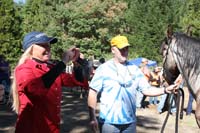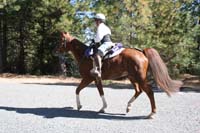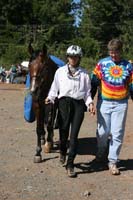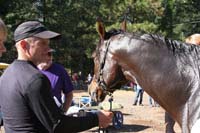

Official Event Website.
Tevis 2011
Tevis 2010
Tevis 2009
Sports Illustrated 1966 - The Cup At The End Of The Mountain Trail
Sports Illustrated 1987 - This is No Joyride
2011 Tevis Cup
Images by Merri Melde








Merri Stories: Tevis Junkies
Diana Hiesalu-Bain Stories: Greatest Ride of My Life || Unsung Heroes - The Crew
Judy Houle: Retackling the Tevis
Current Rider Entry List || Live Webcast
News Stories
Going the distance with endurance riding

Bill Gore Photo
SFGate.com - Full Article
Stephanie M. Lee
Published 06:19 p.m., Tuesday, July 31, 2012
As the saying goes, Nick Warhol knows how to ride a horse into the sunset - for 50 or 100 miles at a time. An endurance horseback rider, Warhol has raced 10,400 miles over two decades' worth of competitions. He couldn't do it, of course, without his trusty steed Donnie, who has 4,300 miles under his metaphorical belt. (Vets check the animals' health periodically during races.) For more information, check out the American Endurance Ride Conference at www.aerc.org.
Name: Nick Warhol
Age: 55
Residence: Hayward
Occupation: Vice president of operations at Vigilent Corp. in El Cerrito
Obsession: Endurance riding
How you got started: I was never a horse person and did not ride a horse until I was 33 years old. I got my wife a horse for a college graduation present in 1990, thinking it would give her a real hobby of her own, since I had so many. I had no idea what a horse really was, or that they were individuals. My plan backfired, and I got sucked in. I got my first horse in 1991, and the rest is history.
Essential equipment: You need a horse (preferably an Arabian), a saddle, a truck, trailer, camper and more horse tack and supplies than you could ever imagine. Having a 10-acre ranch also really helps...
Read more here:
http://www.sfgate.com/health/article/Going-the-distance-with-endurance-riding-3751775.php
Volunteers help hold together Tevis Cup
Auburnjournal.com - Full Article
8/1/12
Some have been involved for more than 20 years
By Amber Marra, Journal Staff Writer
Judy Suter knows that the Tevis Cup isn't just about the horses and riders; it's about the army of volunteers that help make the whole event happen.
Suter is the head volunteer coordinator for the Western States Trail Foundation and oversees the 800 volunteers it takes to make the 100-mile race happen every year.
Of those 800 volunteers there are 40 head volunteers stationed throughout the various checkpoints throughout the race.
Horses have to be checked by a veterinarian at each stop to ensure they can continue on. If they can't, the horse and rider are pulled from the race.
Each checkpoint has around 30 volunteers and usually four veterinarians. Some of the busier checkpoints can have up to 70 volunteers, according to Suter.
Volunteers are responsible for giving riders their timecards so they can know when they were in and out of the checkpoint and at some stops giving weary horses and riders food and water.
Suter, who has two Tevis buckles of her own, knows how exhausting the ride can be and how important the stops are.
"I may ride again someday, but I was doing so many endurance rides at one time I ended up deciding to help with the ride instead," Suter said...
Read more here:
http://auburnjournal.com/detail/214296.html
Horse Health Research Abounds at 2012 Tevis Cup
Thehorse.com - Full Article
by: Marsha Hayes
July 31 2012, Article # 20407
When the 2012 Tevis Cup begins at dawn Aug. 4, more than 200 horses will leave Robie Park near Lake Tahoe, Calif., and proceed toward a finish line 100 miles away in Auburn, Calif. For some competitors it is a race for the cup; for others it's a personal challenge to simply complete the ride in the allotted 24 hours. But for the 15 ride veterinarians and two treating veterinarians, this year's renewal of the Tevis Cup offers a fertile research opportunity.
Head treating veterinarian Langdon Fielding, DVM, Dipl. ACVECC, of Loomis Basin Equine Medical Center, in Loomis, Calif., will lead a study during the ride titled "Creation of a Metabolic Score Based on Basic Laboratory Parameters." In Fielding's letter to ride participants he explained his objective was "to create a metabolic score using basic blood electrolyte and hydration parameters that can be used to identify endurance horses that are metabolically compromised." Tevis treating veterinarian Gary Magdesian, DVM, Dipl. ACVIM, ACVECC, ACVCP, associate professor at the University of California, Davis, School of Veterinary Medicine, and head ride veterinarian Greg Fellers, DVM, have partnered with Fielding for the project.
For each horse that reaches the 36-mile check point, veterinarians will collect a small (1-3 milliliter) sample of blood into a heparinized syringe and analyze it on site. They will do this immediately after the horse has reached the required heart rate of 60 beats per minute or less and before starting the mandatory one-hour hold, or rest period. Anticipated collection time will be approximately five to 10 seconds per horse so as not to delay horses at the check point...
Read more here:
http://www.thehorse.com/ViewArticle.aspx?ID=20407
Information About the Upcoming Tevis Cup Ride
Renegadehorseboot.com - Full ArticleJULY 26, 2012 BY NEWS EDITOR
It is just over one week away from the “Western States Trail Ride,” most commonly referred to as the “Tevis Cup Ride,” or simply, “the Tevis.” The Tevis is the world’s oldest modern endurance ride, first held in 1955, and is also considered “the world’s best-known and most difficult equestrian endurance ride.” The Tevis is officially sanctioned by the AERC (American Endurance Ride Conference.)
Riders have 24 hours to travel the 100-mile course: from the starting point near the shores of Lake Tahoe, just outside of Truckee, CA, across the rugged Sierra Nevadas, to the finishing point in Auburn, CA. Riders must finish with a horse that is deemed “fit to continue” by a team of veterinarians.
Horses must also pass a number of thorough vet-checks held at multiple locations along the trail, some of which also include mandatory rest periods, before being allowed to continue. They are checked for their pulse and respiration, metabolics including hydration and gut function, and a trot-out to evaluate attitude, way of going, and to check for any unsoundness.
The trail can take its toll: historically, only about 50% of those who start the ride will cross the finish line. Horses and riders both have to contend with the mountain trail that is both physically and mentally demanding. The trail itself is rugged, traversing the magnificent Sierra Nevada mountain range. The footing is often extremely rocky, with parts of the trail going through sections of granite rock wilderness. Other parts of the trail travel along hard-packed forest service roads, and even on paved streets through the small towns of Michigan Bluff and Foresthill.
In the last number of years, anywhere from 175-200 horses have started the ride each year: both horse and rider have to be able to contend with the excitement and chaos of that many horses at the start. The ride is held in July or August, as close to the full moon as possible. Summer temperatures soar as the ride descends towards lower elevations, and it is not uncommon for temperatures to reach triple digits within the canyons in the middle of the day.
Riders who cross the finish line with a horse that is deemed “fit to continue” (just as it sounds: the horse should be metabolically and physically sound and able to continue on; a horse who is lame at the finish or is presenting a metabolic issue will not be awarded a completion) are awarded one of the coveted silver completion buckles.
In addition, several other awards are presented:
The Tevis Cup is awarded to the first-place finisher who finished with the fastest time and a horse still “fit to continue.”
The Haggin Cup is the “Best Condition” awarded to the horse finishing in the Top Ten placings who is judged by a team of veterinarians to be “in the most superior physical condition.”
The Josephine Stedem Scripps Foundation Cup recognizes all of the junior riders who complete each year...
Read more here:
http://www.renegadehorseboot.com/information-about-the-upcoming-tevis-cup-ride/
Auburn woman to ride 30th Tevis Cup
Auburnjournal.com - Full ArticleJuly 29 2012
Perry has completed race 21 times
By Amber Marra, Journal Staff Writer
Kathie Perry has seen her fair share of the trail over the years, but fear has never ridden with her.
Perry, of Auburn, will ride in her 30th Tevis Cup next week. She has 21 completions under her belt, one first-place finish in 1978 and has been pulled from the race eight times. She is also the president of the Western States Trail Foundation.
Since she began endurance riding and competing in the Tevis Cup in 1975, Perry has dealt with the challenges of the trail and taken everything that comes with it in stride, including three broken ribs last year.
But when it comes to the day of the ride, she knows no fear.
"Once it starts you're out there but a week after I'll go out and ride the trails again and pull down ribbons and say ‘wow, I did this in the dark or at a trot,'" Perry said. "It all comes back to you and you realize the thing that you've conquered."
Perry started endurance riding around 40 years ago, but she's been around horses her entire life. Originally a Kansas girl, Perry grew up on a farm surrounded by horses.
Her father decided that California would be a better place to raise his children, so they moved to the Bay Area. Eventually, a love of endurance riding would bring Perry and her husband, Ernie Perry, to Auburn. The Perrys rode quarter horses early on in their marriage but switched to Arabians when they became involved in endurance rides.
As a matter of fact, the sole reason Perry wanted to move here was the Tevis Cup...
Read more here:
http://auburnjournal.com/detail/214086.html
Tevis Preparation: Misc. Musings - Karen Chaton
Monday, July 30, 2012Enduranceridestuff Blog - Full Article
It’s interesting how much more effort it takes to prepare for the Tevis Cup than any other ordinary ride. The easiest part is getting the horse ready, it seems. That’s because I’m always riding anyway! Then there is the paperwork, crew arrangements and all of the other organizing and planning that goes into getting ready for the Tevis.
Most of the rides that I attend take little preparation ahead of time especially since I go by myself — I just pack up and go!
Tevis is one ride where there are a lot of details, some big, and some small... that all have to be attended to especially if you want to have a stress free ride on ride day.
So far I’ve got my crew arranged. I’ve got lists made up for each of the stops including checklists for what to pack. I got my entry in late, so I didn’t get a stall at the fairgrounds. As it turns out that is okay as I can keep Bo on the trailer in a dirt lot after the ride is over which will allow me to keep a closer eye on him.
I’ve been going through all of my tack and equipment making sure everything is in good condition and clean. I’m still deciding what headgear to use on Bo for the start of the ride. He goes so well in this one Myler bit, however it has shanks on it that he just HATES if they hit the side of a water bucket, and I don’t want to cause a delay in him drinking because he is bothered by that. I know I’ll be able to change him over to the S-hack but he’s much too strong and fit to start him in that...
Read more here:
http://enduranceridestuff.com/blog/2012/07/tevis-preparation-misc-musings/
Tevis Cup: Dedicated Mile

Sue Walz, Tevis buckle winner in 2004 & 2006, would like to invite all of her father, Bob's friends to participate in the adoption of a mile of trail in Bob's honor. Sue is facing some health challenges of her own and it is her wish that the plaque to commemorate this mile could be presented at the Awards Banquet following this year's ride, August 5, 2012.
Bob's mile, the "Bob Walz Easy Ride Mile", will be mile 76 of the trail, a beautiful stretch of the California Street Loop where can be found a clear spring which fills a trough donated by Julie Suhr. There are many of us who ride Easy Ride Stirrups, now brought to us by our friends at Easy Care.
Bob finished the Tevis in 1976, 1984, 1985, 1986, & 1987.
Donations can be sent care of the Bob Walz Mile, Western States Trail Endowment, 150 Gum Lane, Suite 103, Auburn, CA 95603."
Aberdeen rider, horses shine through endurance
Aberdeennews.com - Full Article
BY JOHN PAPENDICK, jpapendick@aberdeennews.com
3:05 a.m. CDT, July 27, 2012
An Aberdeen endurance horse-riding athlete is continuing to add to her world-class resume.
Kelsey Kimbler won the silver medal aboard her family's purebred Arabian horse Fringant at last week's Federation Equestre Internationale 4-Star Championship 75-mile Endurance Race in Kentucky. Plus, Fringant earned the best-conditioned horse award.
Kimbler and Fringant's time was 6 hours, 11 minutes.
Kimbler is a 19-year-old, 2011 Aberdeen Central graduate who will be a sophomore this fall at Northern State.
On Aug. 4, Kimbler and her Arabian horse Cody Canuck - trained by her older sister Kirsten - will tackle the 57th annual Tevis Cup 100 Miles One Day Ride in California. The American Profile magazine in Monday's American News called the test the nation's most grueling equine endurance ride...
Read more here:
http://www.aberdeennews.com/sports/aan-2b.07-27-12.spts.jpcol-20120727,0,6609742.story
Previously injured Tevis rider to compete again with son
7/27/12
Thomas was thrown from horse in 2008, broke pelvis, crushed bladder By Amber Marra, Journal Staff Writer It's been four years since Luanne Thomas was thrown from a horse in San Francisco, but she still gets nervous when she's in the saddle and things get a little shifty.
Even after completing last year's Tevis Cup, Thomas, of Cool, is still unsure when she's on a trail she isn't comfortable with.
"I still have little panic attacks if my horse stumbles. It takes everything I have to get through some of these narrow trails, even though the accident didn't happen on the trail," Thomas said. "I'm just nervous about waking up in the hospital again."
Thomas will ride in this year's Tevis Cup, but she won't do it alone. This will be the first time her son, Dillon, 13, has ridden the 100-mile endurance race, but he said he's ready, especially after placing first in the junior level of the American Endurance Ride Conference's west region.
"It's just the thrill of it, really. It's just the thrill of Tevis," Dillon said.
Thomas finished the race last year, a big accomplishment for her after taking a few years off from riding.
She did not finish her first attempt at the race and was eager to give it another go in 2008. Thomas was a member of the Sacramento Police Mounted Association for 16 years and decided to attend a training session being held in San Francisco's Golden Gate Park.
That's when Thomas's life was uprooted...
Read more here:
Auburnjournal.com
A Look at the Tevis Trail Maintenance Crew
Tevis Trail Maintenance Report Watson Monument through the Granite Chief Wilderness Area vicinity of Tevis Milepost 14.5 to 19 — Tuesday, July 17, 2012 Tahoe National Forest
by Robert H. Sydnor, Engineering Geologist
AERC Trail Master & Tevis Trail Maintenance Crew
The Tevis Trail Maintenance Crew carpooled from Auburn, assembled in Squaw Valley, then began work at the historic Watson Monument.
Introduction
The six-person Tevis Trail Maintenance Crew included: Michael Shackelford (Trail Crew Boss), Phyllis Keller (deputy leader), Austin Violette, Rob Habel, Zachary Brankline, and Robert H. Sydnor. The team included two AERC Trail Masters.
Phyllis Keller (M-AERC), resides with her husband Bryce Keller (retired CDF Battalion Chief) in Truckee, and is a highly-experienced rider in the Robie Park — Squaw Valley — Truckee area. Her knowledge was valuable for cleverly navigating the complicated network of unmarked jeep roads used in the summertime for ski-lift repair and installation of new ski-lifts. Phyllis Keller has faithfully and diligently served for many years on the Tevis Trail Crew, particularly in the eastern 36 mile-segment from Robie Park to Robinson Flat.
We were able to adroitly ascend on steep gravel roads in a 4-wheel drive truck to a ski-lift terminal that is above High Camp, and only one-half mile from the summit of Emigrant Pass. We parked the truck at about elevation 8,400 feet, and quickly hiked to the Watson Monument at elevation 8,675 feet. During our trail work, we would drop more than 1,100 feet, then return and hike back out over Emigrant Pass.
It was about 68°F with a brisk steady wind at 10 to 15 m.p.h., with bright sunshine and intermittent cumulus clouds; alpine visibility about 40 miles. We used sunblock for ultraviolet protection at high altitude.
The six-person Tevis Trail Maintenance Crew carried three long-handled loppers, hand-held hedge- trimmers, a bow-rake, a machete for chopping brush, and hand-held cross-cut saws.
Hand-Held Trail Tools for the Granite Chief Wilderness Area
Gas-powered engines are not allowed in the wilderness area, so that precluded weed-eaters, high- reach pole-saws, and chainsaws for fallen trees.
U.S. Forest Service officer Mary Sullivan of the American River Ranger District (in Foresthill), Tahoe National Forest, generously lent us a cross-cut saw.
The focus of our work was to improve lateral and vertical clearance for our horses, and to ascertain that there were no newly-fallen trees across the Tevis Trail. Minimal work was performed on the trail-bed.
We carried our daypacks with ample water and lunches, plus an AERC Trail Master carried a "wilderness" First-Aid Kit (that is considerably larger and more specialized than a "standard" First-Aid Kit).
The Tevis Trail Crew paused briefly at the summit of Emigrant Pass to pay homage to the pioneer sheriff Robert Montgomery Watson, who marked this historic route in September 1931...
Read more here:
http://www.endurance.net/international/USA/2012Tevis/WatsonMonumenttoGranite Chief_TevisTrail.pdf
Squaw Valley Construction
 Teviscup.org
Teviscup.org
July 24 2012
From now until Ride Day on August 4th, there will be no riding allowed on the Squaw Valley portions of the trail for safety reasons. There is construction going on, which includes large, noisy trucks traveling down the roads. WSTF will receive special permission to use this property on Ride Day.
America's Toughest Ride: The Tevis Cup
Americanprofile.com - Full Article
by Sherry Phillips
July 17, 2012
Barbara White, 64, rides her 11-year-old mare across No Hands Bridge east of Auburn, Calif. (pop. 13,330), trotting through early morning fog in the Sierra Nevada foothills.
White grins and waves to her mother, Julie Suhr, 88, who stands at the end of the bridge alongside other well-wishers cheering for competitors in the Tevis Cup, the nation’s most grueling equine endurance ride.
“I know the nervousness and excitement they’re all feeling,” says Suhr, a former competitor who 22 times completed the one-day, 100-mile ride on the Western States Trail.
Last October, 177 horsemen and women from around the world, ranging in age from 12 to 69, began the ride, and 123 finished within the required 24 hours to earn a coveted sterling silver belt buckle emblazoned with a Pony Express rider. White received her 31st buckle, more than any other entrant.
“For me the challenge has always been the trail, not the other riders,” says White, a retired schoolteacher who lives in Scotts Valley, Calif. (pop. 11,580). “We cheer for each other, and there’s no shame in not finishing. The slogan of endurance riding is ‘to finish is to win...’”
Read more here:
http://www.americanprofile.com/articles/tevis-cup-endurance-horseback-ride/#ixzz214xZPsK1
57th Tevis Cup Just Over 2 Weeks Away!
July 17 2012The 209 riders from 4 countries are currently registered for the 57th annual Tevis Cup.
Current rider list:
http://teviscup.org/tevis-2012/the-2012-tevis-cup/current-rider-list
The ride agenda has been posted here:
http://teviscup.org/images/docs/2012_ride_week_agenda.pdf
The 2012 Checkpoint information has been posted:
http://teviscup.org/images/docs/2012_ride_week_agenda.pdf
For more information on the ride, see
http://teviscup.org/




